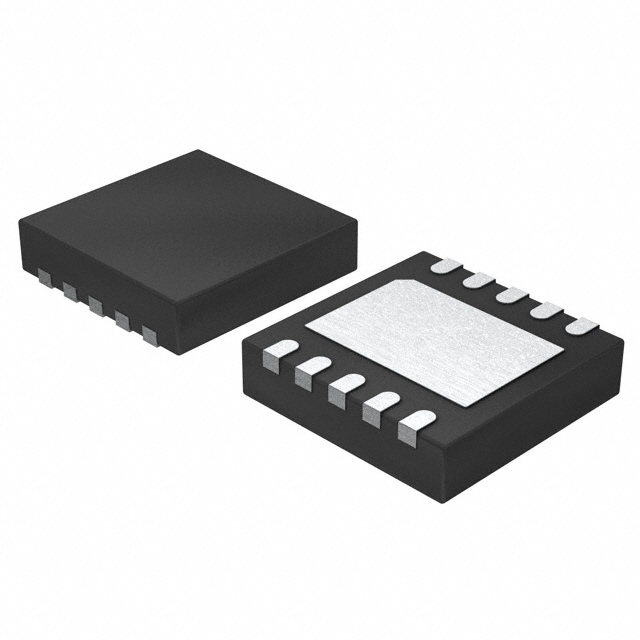LTC3619IDD#PBF
Product Overview
Category
LTC3619IDD#PBF belongs to the category of integrated circuits (ICs) specifically designed for power management applications.
Use
This product is commonly used in various electronic devices to efficiently regulate and control power supply voltages.
Characteristics
- High efficiency: The LTC3619IDD#PBF offers high conversion efficiency, minimizing power losses during voltage regulation.
- Wide input voltage range: It can handle a wide range of input voltages, making it suitable for diverse applications.
- Low quiescent current: The device has a low standby current, ensuring minimal power consumption when not actively regulating voltage.
- Fast transient response: The LTC3619IDD#PBF exhibits excellent transient response characteristics, enabling quick and stable voltage regulation.
Package
The LTC3619IDD#PBF is available in a small form factor package, allowing for easy integration into compact electronic systems. The package type is DFN (Dual Flat No-Lead), which provides good thermal dissipation properties.
Essence
The essence of LTC3619IDD#PBF lies in its ability to efficiently regulate power supply voltages, ensuring stable and reliable operation of electronic devices.
Packaging/Quantity
This product is typically supplied in tape and reel packaging, with a quantity of 2500 units per reel.
Specifications
- Input Voltage Range: 2.25V to 5.5V
- Output Voltage Range: 0.6V to VIN
- Maximum Output Current: 1A
- Switching Frequency: 2MHz
- Operating Temperature Range: -40°C to 125°C
Detailed Pin Configuration
The LTC3619IDD#PBF features a 10-pin configuration:
- VIN: Input voltage pin
- GND: Ground pin
- SW: Switching node pin
- FB: Feedback voltage pin
- EN: Enable pin
- SS: Soft-start pin
- PGND: Power ground pin
- VOUT: Output voltage pin
- BST: Boost pin
- AGND: Analog ground pin
Functional Features
- Wide input voltage range allows for compatibility with various power sources.
- High efficiency conversion minimizes power losses and maximizes battery life.
- Fast transient response ensures stable voltage regulation during load changes.
- Low quiescent current reduces standby power consumption.
- Integrated protection features such as overcurrent and overtemperature protection enhance system reliability.
Advantages and Disadvantages
Advantages
- High efficiency operation
- Wide input voltage range
- Small form factor package
- Fast transient response
- Integrated protection features
Disadvantages
- Limited maximum output current (1A)
Working Principles
The LTC3619IDD#PBF operates based on a switching regulator topology. It utilizes high-frequency switching to efficiently convert the input voltage to the desired output voltage. The device employs a feedback mechanism to regulate the output voltage, ensuring it remains within the specified range even under varying load conditions.
Detailed Application Field Plans
The LTC3619IDD#PBF finds applications in various electronic devices that require efficient power management. Some of the common application fields include:
- Portable electronic devices: Smartphones, tablets, portable media players, etc.
- IoT devices: Wearables, smart home devices, sensors, etc.
- Industrial equipment: Data loggers, measurement instruments, control systems, etc.
- Automotive electronics: Infotainment systems, navigation units, lighting controls, etc.
Detailed and Complete Alternative Models
- LTC3619EDD#PBF: Similar to LTC3619IDD#PBF but available in an alternative package.
- LTC3619HDD#PBF: Higher maximum output current variant of LTC3619IDD#PBF.
- LTC3619IDD-1#PBF: Lower quiescent current version of LTC3619IDD#PBF.
These alternative models offer similar functionality and can be considered as substitutes based on specific requirements.
In conclusion, the LTC3619IDD#PBF is a highly efficient integrated circuit designed for power management applications. Its wide input voltage range, small form factor package, and fast transient response make it suitable for various electronic devices. While it has a limited maximum output current, its advantages outweigh this limitation. The device operates based on a switching regulator topology and finds applications in portable electronics, IoT devices, industrial equipment, and automotive electronics. Alternative models such as LTC3619EDD#PBF, LTC3619HDD#PBF, and LTC3619IDD-1#PBF provide additional options to suit different needs.
Lista 10 Vanliga frågor och svar relaterade till tillämpningen av LTC3619IDD#PBF i tekniska lösningar
Sure! Here are 10 common questions and answers related to the application of LTC3619IDD#PBF in technical solutions:
Q: What is LTC3619IDD#PBF? A: LTC3619IDD#PBF is a specific model number for a power management integrated circuit (PMIC) manufactured by Linear Technology (now part of Analog Devices). It is designed for use in various technical solutions.
Q: What are the key features of LTC3619IDD#PBF? A: The LTC3619IDD#PBF PMIC offers high efficiency, low quiescent current, multiple output voltages, and a wide input voltage range. It also includes protection features such as overvoltage and overcurrent protection.
Q: What are the typical applications of LTC3619IDD#PBF? A: LTC3619IDD#PBF can be used in a wide range of applications, including portable devices, industrial equipment, automotive systems, and battery-powered devices.
Q: What is the input voltage range supported by LTC3619IDD#PBF? A: The input voltage range of LTC3619IDD#PBF is typically between 2.25V and 5.5V.
Q: How many output channels does LTC3619IDD#PBF have? A: LTC3619IDD#PBF has two independent output channels, which can be configured to provide different output voltages.
Q: What is the maximum output current supported by LTC3619IDD#PBF? A: The maximum output current per channel of LTC3619IDD#PBF is typically 600mA.
Q: Does LTC3619IDD#PBF support synchronous rectification? A: Yes, LTC3619IDD#PBF supports synchronous rectification, which helps improve efficiency.
Q: What is the operating temperature range of LTC3619IDD#PBF? A: The operating temperature range of LTC3619IDD#PBF is typically -40°C to 125°C.
Q: Does LTC3619IDD#PBF have any built-in protection features? A: Yes, LTC3619IDD#PBF includes various protection features such as overvoltage protection, overcurrent protection, and thermal shutdown.
Q: Is there any evaluation board available for LTC3619IDD#PBF? A: Yes, Analog Devices provides an evaluation board for LTC3619IDD#PBF, which can be used for testing and prototyping purposes.
Please note that the answers provided here are general and may vary depending on the specific datasheet and application requirements. It is always recommended to refer to the official documentation and consult with technical experts for accurate information.


